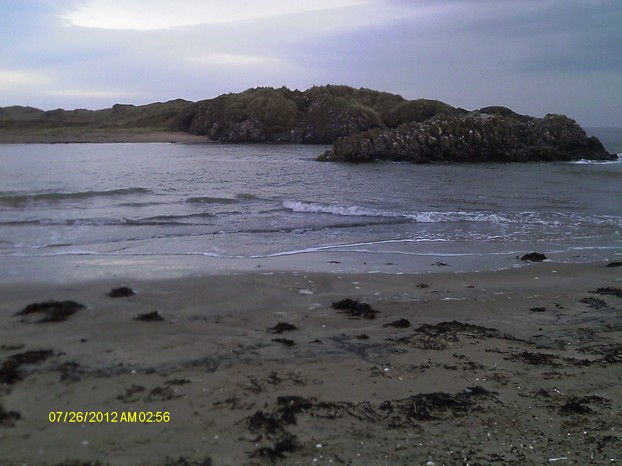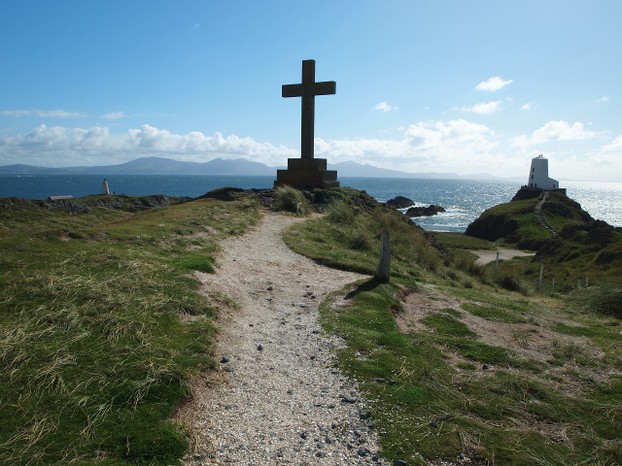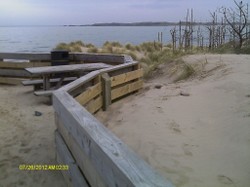The best way to access the forest is to drive through the village of Newborough and follow the signs. On the bend as you pass through the village there is a path to a car park that provides access to the beach by a forest walk, but the main car park, with the facilities is further up the road and is well sign-posted. On foot you can walk in free, but cars have to pay. The price is currrently £4, which is not bad. This is not a National Trust property, so my National Trust card does not let me in for free.From the car park there is access to either the beach or to forest walks.
The forest is mainly conifer [Corsican Pine] woodlands, though there is some birch, a tree that self seeds anywhere and which is proving popular with foresters as it provides a fast growing crop for the sale to the many Britons who have wood burning stoves, of whom I am one. The forest fringes onto the dunes, and there is some evidence that some trees on the dune and cliff fringe have fallen victim to erosion in the savage storms that have beset Britain in the last few years.
What strikes me about walking through Newborough Forest is the deep silence. You walk along well-constructed paths amidst tall trees in an atmosphere of almost religious quiet, undisturbed by engines. The combination of low light caused by the shading effect of the tall trees and the almost undisturbed quietness of the woodland is calming indeed. Occasionally you hear the cawing of ravens, but there are few squawks of gulls, as these pragmatic scavengers lurk in the towns where they know there is food to eat. The occasional natural bird sound plays descant to the silence. Strange that natural sounds such as bird song and the sighing of the wind amidst tall trees does not disturb in the way that unnatural sounds do. We are meant, I believe, to enjoy noise only against a background of silence. Such sound is not oppressive as the sounds of the city sometimes are.
Occasionally we see the forest's most treasured residents. Red squirrels! These little fellows are under threat in Britain, as they were out-competed by the more muscular American Grey Squirrel, which also carries a virus fatal to the red. But the red has one advantage, it can nest and live in conifer, whereas the grey cannot, so the various conifer woods are now a refuge for this threatened native species. However, they are shy, so be glad if you see one, but do not expect to do so. The best way to see them is to sit and wait.










 Pilgrimage. A review15 days ago
Pilgrimage. A review15 days ago
 Leo the Fourteenthon 05/09/2025
Leo the Fourteenthon 05/09/2025
 The Melsonby Hoardon 03/25/2025
The Melsonby Hoardon 03/25/2025



Comments
No. I have no such information.
The percentage is known to specialist biologists, but I do not know it.
Thank you for your comment below, in answer to my previous observation and question.
Your advising us that "adjusting Linnaeus' work is acceptable" intrigues me.
Is there any information anywhere as to what percentage of the Linnaean output subsequently is revised?
There is a committee that meets yearly to discuss the allocation and reallocation of taxonomical classifications. So adjusting Linnaeus' work is acceptable.
Thank you for your comment below, on Aug. 25, 2017, in answer to my previous observation and question.
The silverweed reclassification intrigues me.
Is it always, never, sometimes controversial to reclassify what Carl Linnaeus realized taxonomically?
Thank you for your comment below, on Aug. 25, 2017, in answer to my previous observation and question.
The silverweed reclassification intrigues me.
Is it always, never, sometimes controversial to reclassify what Carl Linnaeus realized taxonomically?
Dropping the bread crumbs was to create a pattern that a diviner could read.It was like reading the tea leaves.
Silverweed was initially placed in the genus Potentilla by Linnaeus, hence Potentilla anserina, but in the 1990s it was reclassified as a member of the genus Argentina, hence Argentina anserina. The reclassification was controversial and some authorities will not accept it.
frankbeswick, Why were bread crumbs dropped into the well? I'm trying to imagine how quickly they would break down and what the impacts would be on water quality.
Also, is silverweed Argentina anserina?
The picture above gives a view of the hills of the Lleyn Peninsula.
It is a lovely place.I did not say that this week the viewing platform, which you see in the thumbnail, is being shortened because of coastal erosion. I think, though, that erosion there is simply widening the beach.